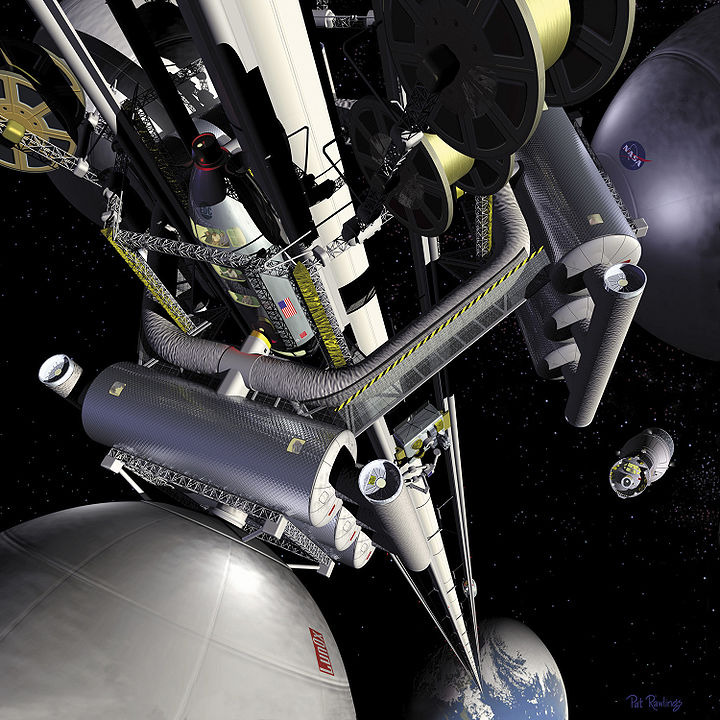
I learned this today. With the technology we have today a space elevator isn’t possible, but it could be possible in the not so distant future.
The main idea for a space elevator would have a cabled anchored somewhere on the surface of the Earth. The other end of the cable would be attached to a hub, acting as a counterweight, that was at a height of approximately 100,000km. The hub would be kept in place and the cable kept taught because of gravity and centrifugal force. Gravity would act upon the cable up to 36,786km and centrifugal force would act upon it from there. 36,786km is the height of geostationary orbit and it is where communications satellites are usually placed. Up to that height, gravity will be pulling downwards on the cable and after that height centrifugal force will be pulling upwards on the cable. Elevators would be able to ascend and descend the cables, releasing cargo into orbit.
The idea of a space elevator was raised by Russian scientist Konstantin Tsiolkovsky. He saw the Eiffel Tower and imagined a similar tower that would stretch all the way into orbit. There is no way a solid tower would be possible because there is no material known that could support that much weight. In 1959, a Russian engineer, Yuri Artsutanov, suggested using a satellite as a counterweight and suspending a cable from it that would be anchored to Earth. This is where the idea for the tensile cable comes from.
Anything like a space elevator would be a monumental construction project that would cost billions and tax technology to its limits. What would be the benefits of such a machine?
It would cost less to get things into orbit. Up until 2000, it cost about $18,500 to get 1kg of material into space on the space shuttle. Since the development of reusable private space rockets, that price has fallen to about $2,720. That price will continue to fall, but it may never get as low as a space elevator. Calculations show that it could be as cheap as $50 a kg to get material into space. This would mean the building of space stations or interstellar space rockets would be much more affordable. You could send up items that wouldn’t fit in a space shuttle and you could potentially even build a moon base.
So, what is stopping humanity building one?
The first problem to be overcome is the enormous stress that a space elevator would experience. The greatest stress on the cable is at the point of geostationary orbit. If a steel cable was used, the forces would be about 60 times greater than the tensile strength of steel. The best way to overcome these forces would be to taper the cable because the stresses would be lowest at the ground point and the space end point, but highest at the geostationary orbit point so, if the cable was tapered, it would make the stresses close to equal along the length.
However, if the cable was made from steel, the tapered point would have to be too thick to be reasonable and the whole weight of the cable would be too heavy to sustain.
The solution? Carbon nano tubes, or graphene as it is known. This is a material that is 200 times stronger than steel and 6 times as light. This material would be perfect as a material for the cable. The only temporary problem is that there is no way yet to make it in the lengths and quantities required, but that problem will be solved.
The second problem is the tether. It will have to withstand high stresses. There would also be the question of where to put it? If it is on land, in which country? Should it be on a mountain to reduce the distance to space? Should it be an ocean based tether? These are all problems that can be solved.
A third problem is the elevator itself. All elevators on Earth are raised and lowered by the cable that they are attached to. A space elevator cannot do this because its cable will not be able to move. The elevator will have to be able to climb up and down the cable under its own power. It will also need to be airtight and safe for people to ride in.
A fourth problem is space debris. NASA currently tracks 500,000 pieces of space debris. Rockets and space stations can be maneuvered around these pieces, but a static space elevator could not. One solution would be to tether the elevator in the sea so that it can be moved. However, to move such a massive object would be a fairly difficult endeavor that wouldn’t be quick. One solution would be a laser targeting system. It would target space debris, superheating one side of it. That would cause a slight decompression that would push the space debris to one side or the other. This would protect the space elevator and could be used to clean up space.
Many of the problems facing a space elevator have been or will very soon have been solved. A Japanese company has said that they will build a space elevator by 2050 and a Chinese company has gone one better and promised 2045. Will we see a space elevator soon? Probably not in the next ten years, but in the next 25? The chances are good. And this is what I learned today.
Image By NASA/Pat Rawlings – NASA: https://commons.wikimedia.org/w/index.php?curid=326317
Sources
https://www.pbs.org/wgbh/nova/sciencenow/3401/02-why.html
https://www.slashgear.com/is-a-space-elevator-possible-using-todays-technology-24708424/
https://www.slashgear.com/is-a-space-elevator-possible-using-todays-technology-24708424/
https://en.wikipedia.org/wiki/Space_elevator
https://www.bbc.com/future/article/20150211-space-elevators-a-lift-too-far
https://theconversation.com/how-spacex-lowered-costs-and-reduced-barriers-to-space-112586
https://users.wpi.edu/~paravind/Publications/PKASpace%20Elevators.pdf
